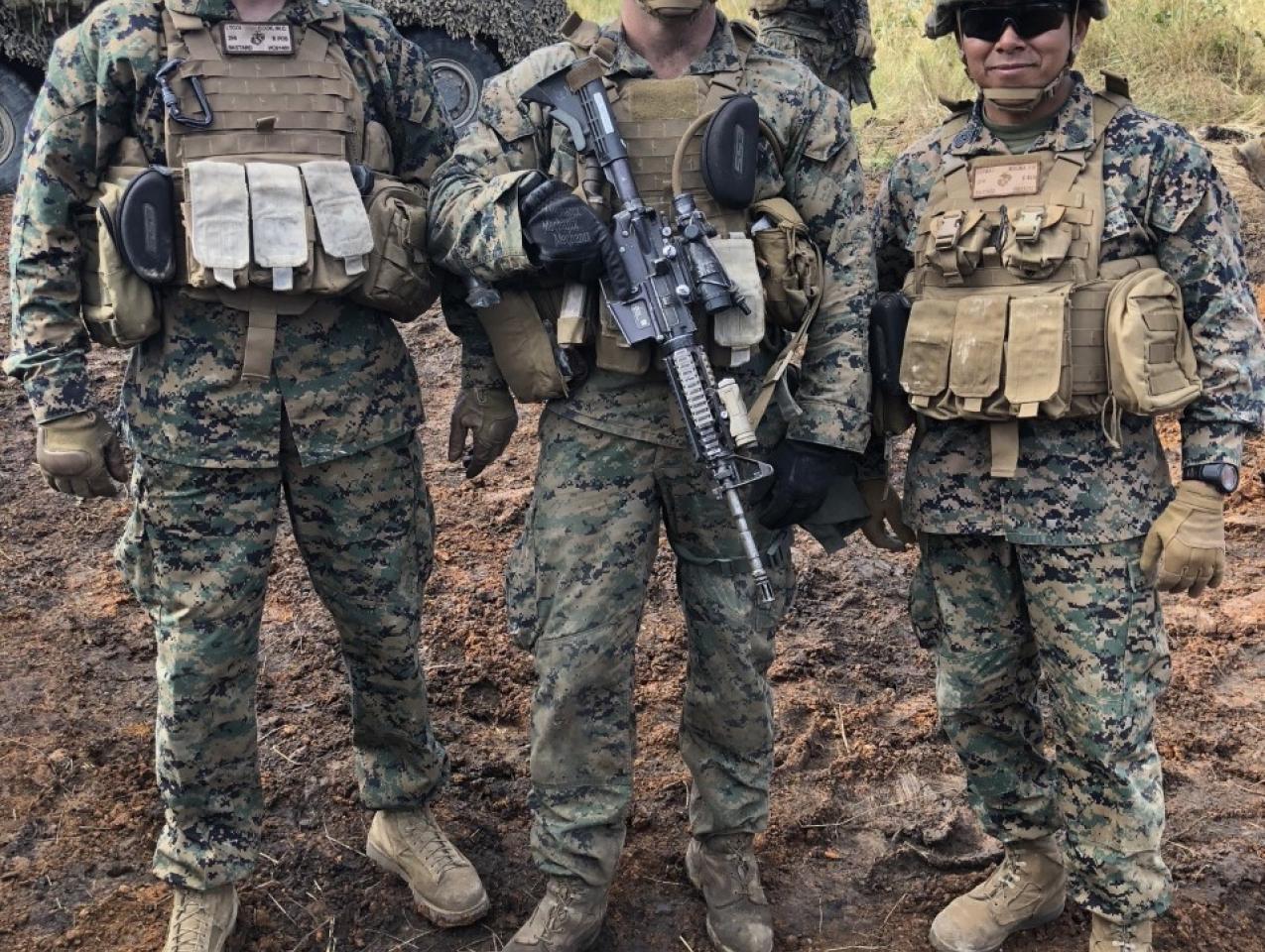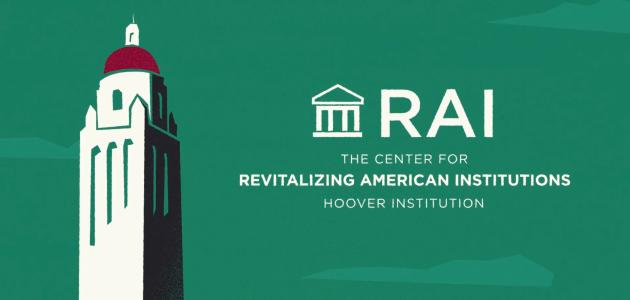
by Jonathan Movroydis
Lieutenant Colonel Warren C. Cook Jr., representing the US Marine Corps, is a National Security Affairs Fellow (NSAF) for the academic year 2019–20 at the Hoover Institution.
In this interview, Lt. Col. Cook discusses his 20-year journey in the Marine Corps and many diverse assignments, including serving as aide to General James Mattis (now Davies Family Distinguished Fellow), leading Marines in deployments to Afghanistan and Iraq, and commanding Marine recruiters in the greater Los Angeles area. Lt. Col. Cook also discussed his research focus at the Hoover Institution about how the Marine Corps can optimize lethality through best practices used in the sectors of technology and professional sports.
Why did you join the US Marine Corps?
My father was an infantry officer in the US Marines Corps and served in Vietnam. Growing up, I had been exposed to the culture of the Marine Corps. My father’s friends were his fellow Marines. They also happened to be his college friends too.
I am a team player. I attended Williams College in Massachusetts, where I ski raced, as well as played college football and junior varsity lacrosse. The idea of playing for a big team of cocky guys who want to go fight in any clime and place really appealed to me. That is why I joined the US Marine Corps.
I enrolled in the Corps’ Platoon Leaders class, spending seven weeks at Officer Candidate School in the summer of my freshman year. I qualified to come back to OCS during the summer of my junior year, completed my training, and was commissioned as a second lieutenant upon graduation in 1998.
I was selected as an infantry officer and then sent to Camp Pendleton in 1999. Coincidentally, I was assigned to the same company battalion as my father was in Vietnam, Fox Company, 2nd battalion, 4th Marines. I was deployed to Southeast Asia during peacetime, and spent Y2K in Okinawa, Japan. The world didn't end.
How were you chosen to be the aide of General James Mattis?
At the time, General Mattis was deputy commander of the Marine Expeditionary Force. He was a one-star general. The Marine Expeditionary Force was comprised of three elements: the 1st Marine Division (infantry), the 3rd Marine Air Craft Wing, and the 1st Service Support Group. Each of these three entities provided a candidate to be interviewed by Gen. Mattis.
During my interview, Gen. Mattis asked, “Do you want the job?” I said, “No sir,” because I wanted to remain in my battalion with my fellow lieutenants—we’d extended our contracts to make the next deployment. He said, “Okay, you’re hired.”
Gen. Mattis was like he is today: no better friend, no worse enemy—the consummate coach, personable, intellectually and physically at the top of his game.
Before morning meetings in San Diego with the Navy, we left Camp Pendleton at 5 a.m. to beat the traffic and worked out at the Recruit Depot. We then changed, ate breakfast, and went to our meeting. He maintains this discipline of early morning workouts to this day—professionally, intellectually and physically at the top of his game. The Corps expects nothing less.
I was at Gen. Mattis’s side for almost every meeting in my two and a half years as his aide. As a lieutenant, I walked the halls of the White House, and turned slides as he briefed then national security advisor Condoleezza Rice following the invasion of Afghanistan in 2001. He was a great mentor.
When were you first deployed to the combat zone?
My original plan was to serve in the Marine Corps for four years and then become a businessman in Europe, where I could use my French-speaking skills and enjoy skiing and hiking in the Alps.
And then 9/11 happened. I ended up joining Gen. Mattis on two combat tours—the invasions of both Afghanistan and Iraq. I subsequently rose through the ranks and served multiple deployments in Iraq as a company commander, and then as a military advisory team leader with the rank of major.
In 2008, the Iraqi military had performed ably in the fight against the Mahdi Army in Sadr City. It was pretty clear they could take care of themselves, and didn’t need oversight from US Marines. We were then sent to secure Iraq’s western border and advise Iraq’s border patrol, serving under then Lt. Gen. John Kelly (future White House chief of staff) who was then commander of Multi-National Force, West Iraq.
What has been one of your biggest career challenges?
I was selected as the commander of the US Marine Corps recruiting station in Los Angeles for a three-year tour of duty. I was in charge of enlisted and officer procurement in Los Angeles, Kern, Ventura, and Santa Barbara Counties. I was essentially the regional sales manager for more than 15 offices, including two officer selection offices—one at USC, and one at UCLA. Thanks to the hard work of the entire team, the tour was a success. It was hard, but rewarding.
When describing recruiting duty, Marine Commandant [Carl] Mundy put it best: “There is no more demanding job at any grade.” A recruiting station is the only unit in the Marine Corps that is in contact with its objective 30 days a month, every month, without letup. Further, when one considers the 20 million 18–25-year-old males in the United States, only about 800,000 are qualified for and have a propensity to join the military. Clearly, while we have an “all-volunteer force,” it is really an “all-recruited force.” Hence, this gives you an understanding of the uphill battle Marine recruiters wage and win.
As the commander, I had to understand the region’s demographic, cultural, and political realities and allocate our command’s resources in a manner where we could best achieve our recruiting goals. It is a fascinating nexus.
What was your path to the Hoover Institution?
After recruiting duty, I was sent to US Naval War College in Newport, Rhode Island, where I received a master’s degree in national security studies. During my recruiting tour in California, my wife continued her work as an attorney in New York. She was able to join me in Rhode Island and worked for the college’s Judge Advocate General (JAG) office.
I then went to the Pentagon to serve as an aide to the commandant of the Marine Corps, and spent a tour of duty in US Indo-Pacific Command’s office of strategy and plans.
My final assignment before arriving at Hoover was as commander of the 2nd Battalion, 4th Marines in Camp Pendleton. I led the 2nd Battalion in a deployment to Darwin, Australia, as part of the Marine Rotational Force–Darwin. The deployment was the seventh annual and part of the 25-year Force Posture Agreement the United States signed with Australia in 2010. It postures the United States with its strongest ally in the region to deter and fight adversaries. It was an absolute pleasure to serve alongside the Aussies—the Marines would gladly storm the Gates of Hell and drink the devil’s liquor with the Aussies on our right flank.
In the end, the Marines performed magnificently, and was I lucky enough to get selected to be an NSAF at Hoover—my first choice.
What are your research objectives at the Hoover Institution?
My objective is to adopt the best practices and cutting technology used in professional sports in a way that optimizes the lethality of the Marine Corps.
When I was at the 2nd Battalion, 4th Marines we had sought advice from the Los Angeles Rams and the USC football team about how to integrate film into our training regimen.
In sports, coaches use film to evaluate player performance. Yet in the Marine infantry, film is used quite sparingly. There are some resourceful young sergeants who record on their smartphones to supplement training, but it is an ad hoc effort.
This motivated the team to start a pilot program in which we measured the activities of two platoons and compared whether the platoon using film performed better than the one who did not. The production teams of the LA Rams and the USC Trojans demonstrated their filming and editing techniques, which enable coaches and players to analyze their past gameplay and use that information to optimize their performance in future matchups.
The second area of my research entails the use of wearable technology to measure physical fitness. A wearable might be used to diagnose predispositions to musculoskeletal issues, and inform progress of a Marine’s physical therapy and return from injury.
It could also be used to determine electrolyte or hydration levels in a Marine’s body. Ostensibly, a commander leading a platoon on a hike through Camp Pendleton would be able to check the hydration levels of his Marines using his tablet.
The third research area surveys the use of sophisticated methodologies to ensure past practices for human resources management in the Marine Corps. This means developing systems that enhance the due diligence process for recruitment, personnel assignment, and command selection. This process would analyze performance and physical intangibles, as well as the psychology of recruits and Marines within the ranks.
An analogous example is how the best Major League Baseball teams use analytics to evaluate the performance of available draft picks, promote prospects within the minor league system, and construct regular season and playoff rosters.
I have recently worked with Sandy Alderson, former Oakland Athletics general manager, who has been very helpful in my research.
Another facet of my research covers how the US Marines selects commanders at the lieutenant colonel level. I would like to find out how this can be enhanced. Perhaps there is another layer of information that can be provided to the Marine Corps selection boards?
My next assignment will be as operations officer for US Marine Corps recruiting command. For this role, I plan to work with Hoover’s education and demography experts and explore how these aspects might impact future recruiting classes.
I will submit my recommendations to the Marine Corps and report the best practices that should be adopted in particular areas, which may include recruit training and military occupational selection.
Which Hoover Institution colleagues have been particular helpful in your research?
Gen. Mattis has been helpful in connecting me with officials from the Close Combat Lethality Task Force, who looked at a similar problem set and mined it for best practices.
Peter Robinson has been very helpful in connecting me with Sandy Alderson and John Lynch, the general manager of the San Francisco 49ers.
I will probably enlist the business and engineering schools for help on data analytics.
What do you do for fun?
I have four children under five years old. I have enjoyed teaching them how to ski and play tennis and soccer. We have also been learning how to cook and speak Spanish.




















